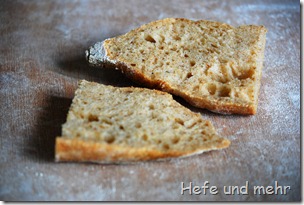 After the delicious Wheatbread with old bread I wanted to try another recipe with old bread preferment as well. Lutz’ Altbrotstangen make whishing for some baguettes of my own and so I started to rethink a recipe I created about 2 years ago.
After the delicious Wheatbread with old bread I wanted to try another recipe with old bread preferment as well. Lutz’ Altbrotstangen make whishing for some baguettes of my own and so I started to rethink a recipe I created about 2 years ago.
The Baguette with 3/4 Sponge and cold Autolysis had a great taste but I did not like how they look then. So I decided to change some parameters of the recipe, adding an old bread preferment and some gluten. The dough I got with the changed recipe was soft but not sticky and easy to handle.
When I shashed the baguettes I was already hopeful that this time the baguettes would look as perfect as the baguette I was dreaming of. And when I drew them out of the oven I was stunned because they were so beautiful. The most beautiful baguettes I ever bake.
And their taste is great, too. The two preferments add a complex flavour to the bread and the old bread adds nutty nuances to the taste. A delicious bread, which I will bake often for sure.
Baguette with “old bread”, 3/4 Sponge and cold Autolysis
Cold Autolysis
- 475g flour Type 550
- 25g Gluten
- 300g water (ice cold)
Preferment with old Bread
- 200g dried (Whole Wheat-)Bread, crushed into breadcrumbs
- 400g Water
- 1g fresh yeast
Sponge
- Dough from the cold autolyze
- 20g water

- 2g fresh yeast
Dough
- preferment with old bread
- Sponge
- 300g flour Type 550
- 20g Salt
- 25g Water
Cold Autolysis: Mix flour and cold water at the morning and place in the fridge for 12 hours .
For the bread ferment crush the bread to fine crumbs, mix crumbs with yeast and water. Ferment for about 24 hours in the fridge.
Sponge: Dissolve Yeast in Water and add to the dough from the cold autolysis. Knead until homogenous. Ferment for 12 hours (overnight) at room temperature (20°C).
At the next morning add preferment, water, flour and salt to the sponge and knead by hand until homogenous. Let rise for 3 hours, folding the dough every 30 min.
Divide the dough into pieces of 200g, preshape to a loaf (15 cm long) and rest for 20 min. Roll into a baguette (35 cm length) and proof on a well floured couch for about 1 hour.
In the meantime heat the bread baking stone to 250°C. Slash three times prior to baking.
Bake at 250°C for 25-30min with steam.
I sent this entry to Yeastspotting, Susans weekly showcase of yeast baked good.
Deutsch



Hallo Stefanie,
Wow, was für ein Geschmack !!! Ich hab die Baguettes für ein Abendessen mit Antipasti, Feldsalat und gebackenem Ziegenkäse gemacht. Das hat sehr gut gepasst und die Gäste waren begeistert 😀
Zuerst war ich nicht so angetan über die Gehzeit und das halbstündige Falten. Es war aber so spannend zu sehen, wie sich der Teig durch das Falten verändert und entwickelt. Das Aroma hat mich dann restlos überzeugt. Also wieder einmal vielen Dank für ein köstliches Rezept.
Liebe Grüße
Martina
@Martina: Das freut mich – und das Abendessen klingt ja ausgesprochen fein!
Hallo Frau Bäckerin,
hab durch meine Tochter dieses Rezept entdeckt und am Wochenende nachgebacken. Ich bin begeistert !
So ein guter intensiver Brotgeschmack ! Meine sehen optisch nicht so schön aus, weil ich noch unsicher im Umgang mit dem gegangenen Teig bin, aber doch viel besser als alle vorherigen Versuche.
Und ich bin auch begeistert von den vielen schönen Rezepten und genauen Anleitungen im diesem Blog….und natürlich von den Bildern !
Vielen lieben Dank !
@Rena: Das freut mich 🙂 und das hübsche Aussehen kommt mit der Zeit, da hilft nur üben 😉
Ich bin, was Brot backen angeht ein blutiger Anfänger und würde gerne Dein “Baguette mit “Altem Brot”, 3/4 Sponge und kalter Autolyse” nachbacken.
Ich habe aber kein Gluten zur Hand.
Warum sind in Deinem Rezept für die kalte Autolyse 25g Gluten angegeben? kalte Autolyse
•475g Mehl Type 550
•25g Gluten
•300g Wasser (eiskalt)
Normalerweise brauch man das doch nicht. Du hat mit Sicherheit einen Grund und eine Erklärung dafür.
Über eine Antwort würde ich mich sehr freuen.
liebe Grüße
Elora
@Elora: Das Gluten habe ich zugesetzt um auszugleichen, dass der Altbrot-Vorteig kein Gluten zur Verfügung stellt und so ein höheres Gebäckvolumen zu erreichen. Man braucht es aber nicht unbedingt. Du kannst das Gluten einfach durch Mehl Type 550 ersetzen und evt. die Wassermenge um 15g reduzieren.
Pingback: Hefe und mehr » Blog Archive » Jahresrückblick 2012
Hallo STefanie,
wieso benutzt du in diesem Rezept Gluten bei der kalten Autolyse? Welche Funktion erfüllt es? Wird bei der Autolyse viel Gluten abgebaut durch Enzyme?
@Alexander: Das Gluten habe ich nicht zugesetzt, um Gluten zu ersetzten, das bei der Autolyse verdaut wird sondern um Auszugleichen, dass der Altbrot-Vorteig kein Gluten zur Verfügung stellt.
Bei der Autolyse passieren zwei Dinge, zum einen werden die Proteine im Teig hydriert und es bilden sich die ersten Disulfid-Brücken des Glutennetzwerks, zum anderen wird ein Teil des Netzwerks durch die Proteasen wieder abgebaut. Allerdings wird nicht so viel abgebaut, dass der Teig dadurch an Stand verliert.
Your baguettes are indeed stunning! And I love the idea of cold-fermenting both the autolyse and the old bread.
Huhu,
deine Baguette sehen aus, wie aus dem Bilderbuch, echt toll, ich vermute, dass sie auch mindestens so lecker schmecken =) Die muss ich auf jeden Fall ausprobieren.
LG, Stephi
@Stephi: Vielen Dank 🙂 Sie sind wirklich sehr lecker, durch die große Vorteigmenge werden sie sehr aromatisch.
Schön sehen sie aus, Stefanie!
@Lutz: Danke schön! 🙂 Und danke für die Idee!